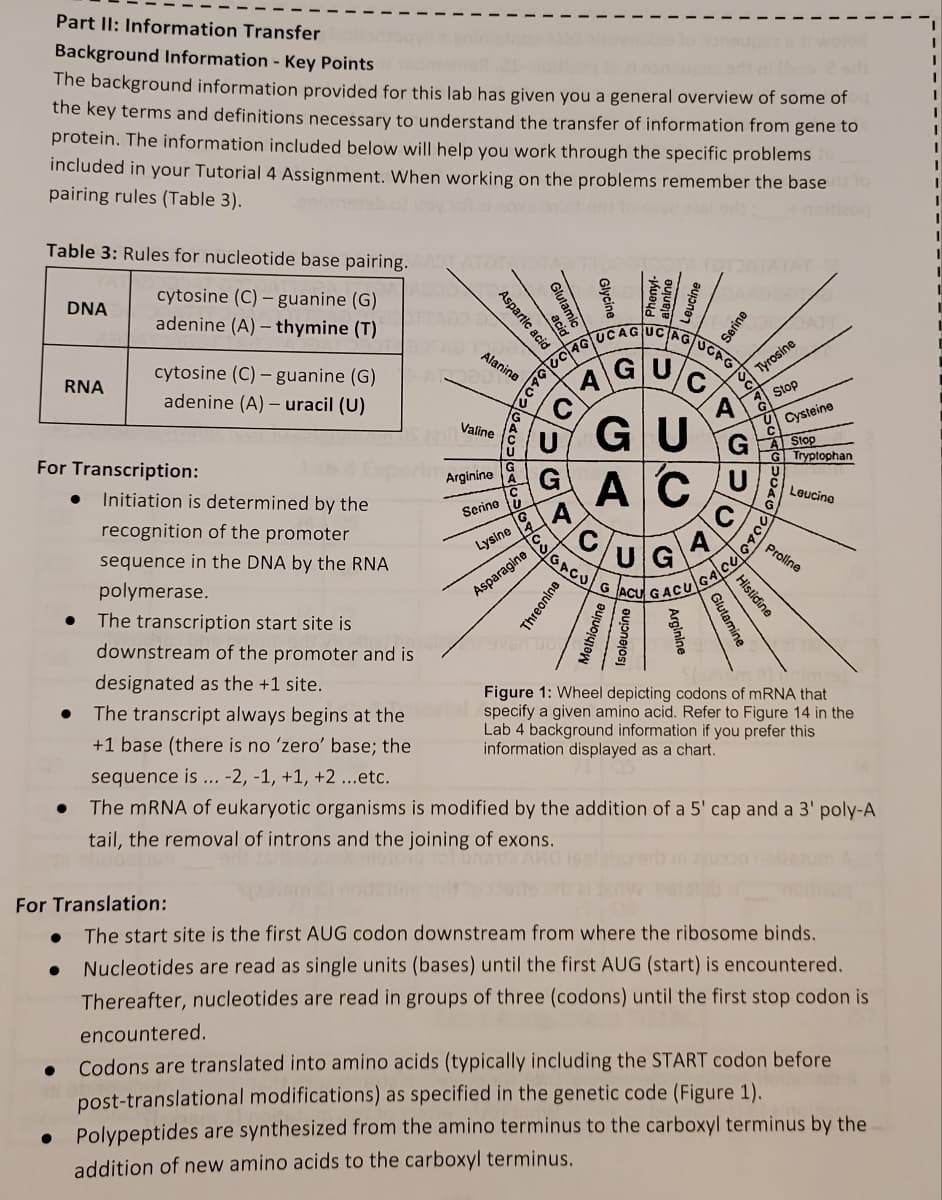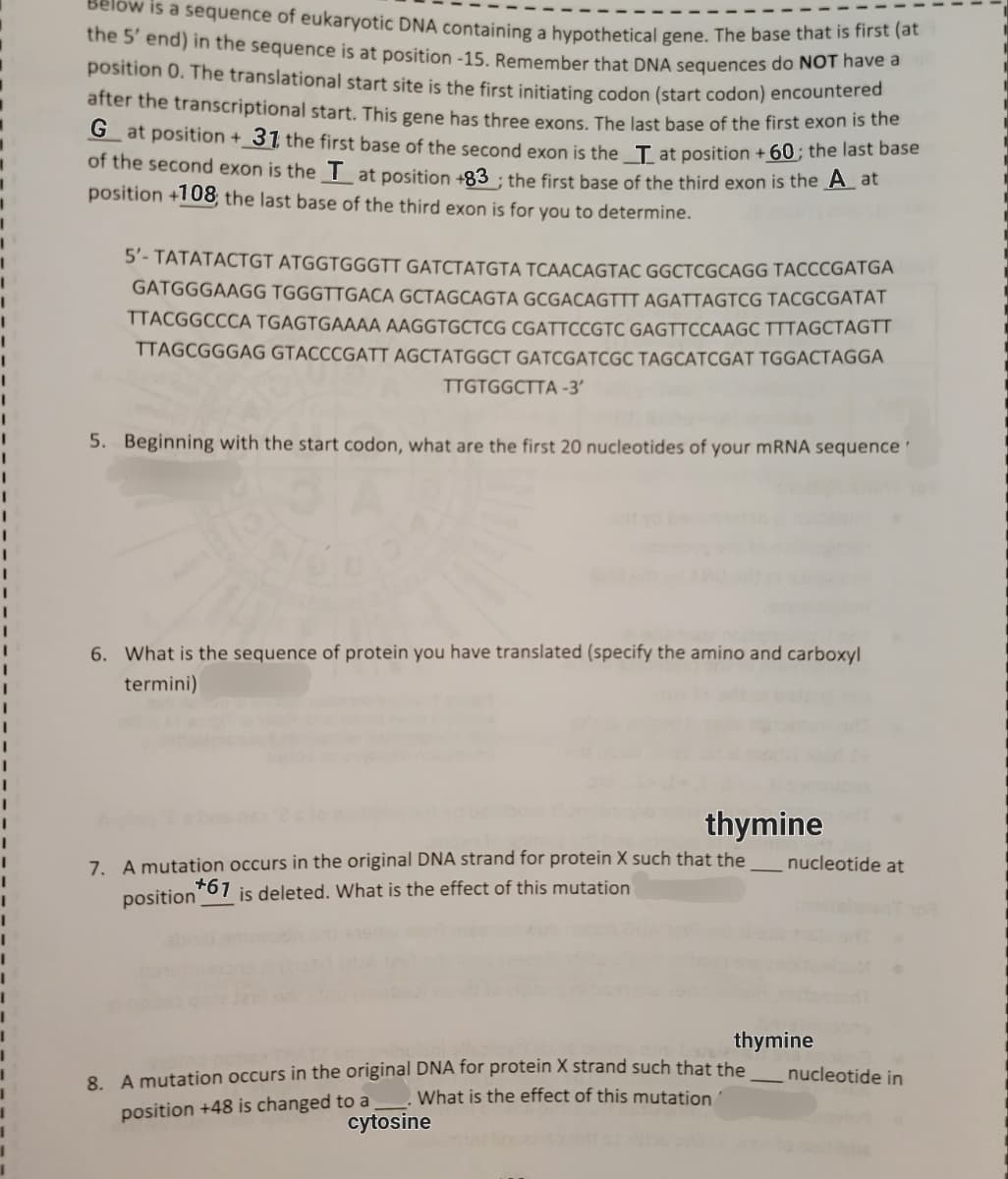1 5'- TATATACTGT ATGGTGGGTT GATCTATGTA TCAACAGTAC GGCTCGCAGG TACCCGATGA GATGGGAAGG TGGGTTGACA GCTAGCAGTA GCGACAGTTT AGATTAGTCG TACGCGATAT TTACGGCCCA TGAGTGAAAA AAGGTGCTCG CGATTCCGTC GAGTTCCAAGC TTTAGCTAGTT TTAGCGGGAG GTACCCGATT AGCTATGGCT GATCGATCGC TAGCATCGAT TGGACTAGGA TTGTGGCTTA-3' 5. Beginning with the start codon, what are the first 20 nucleotides of your mRNA sequence' 6. What is the sequence of protein you have translated (specify the amino and carboxyl termini)
1 5'- TATATACTGT ATGGTGGGTT GATCTATGTA TCAACAGTAC GGCTCGCAGG TACCCGATGA GATGGGAAGG TGGGTTGACA GCTAGCAGTA GCGACAGTTT AGATTAGTCG TACGCGATAT TTACGGCCCA TGAGTGAAAA AAGGTGCTCG CGATTCCGTC GAGTTCCAAGC TTTAGCTAGTT TTAGCGGGAG GTACCCGATT AGCTATGGCT GATCGATCGC TAGCATCGAT TGGACTAGGA TTGTGGCTTA-3' 5. Beginning with the start codon, what are the first 20 nucleotides of your mRNA sequence' 6. What is the sequence of protein you have translated (specify the amino and carboxyl termini)
Biochemistry
6th Edition
ISBN:9781305577206
Author:Reginald H. Garrett, Charles M. Grisham
Publisher:Reginald H. Garrett, Charles M. Grisham
Chapter28: Dna Metabolism: Replication, Recombination, And Repair
Section: Chapter Questions
Problem 16P: Helicase Unwinding of the E. coli Chromosome Hexameric helicases, such as DnaB, the MCM proteins,...
Related questions
Question

Transcribed Image Text:Part II: Information Transfer
Background Information - Key Points
The background information provided for this lab has given you a general overview of some of 24
the key terms and definitions necessary to understand the transfer of information from gene to
protein. The information included below will help you work through the specific problems
included in your Tutorial 4 Assignment. When working on the problems remember the base mu to
pairing rules (Table 3).
Table 3: Rules for nucleotide base pairing.
cytosine (C) - guanine (G)
adenine (A)- thymine (T)
DNA
RNA
For Transcription:
●
●
●
●
cytosine (C) - guanine (G)
adenine (A)- uracil (U)
Initiation is determined by the
recognition of the promoter
sequence in the DNA by the RNA
polymerase.
Stef
The transcription start site is
downstream of the promoter and is
designated as the +1 site.
Aspartic acid
Alanina
Valine
Arginine
Serine
Lysine
Asparagine
Glutamic
TEOPO|0C|AGUCAG|UC|AG/DCAG/3G/
CAGUC
UGU
A C
A
Threonine
G
Methionine
Isoleucine
Serine
Arginine
Glutamine
U
UG
ACU GACU GAC OTOCk
Tyrosine
Histidine
Stop
Cysteine
Stop
Tryptophan
1040
Leucine
Proline
Figure 1: Wheel depicting codons of mRNA that
specify a given amino acid. Refer to Figure 14 in the
Lab 4 background information if you prefer this
information displayed as a chart.
The transcript always begins at the
+1 base (there is no 'zero' base; the
sequence is ... -2, -1, +1, +2 ...etc.
The mRNA of eukaryotic organisms is modified by the addition of a 5' cap and a 3' poly-A
tail, the removal of introns and the joining of exons.
For Translation:
The start site is the first AUG codon downstream from where the ribosome binds.
Nucleotides are read as single units (bases) until the first AUG (start) is encountered.
Thereafter, nucleotides are read in groups of three (codons) until the first stop codon is
encountered.
Codons are translated into amino acids (typically including the START codon before
post-translational modifications) as specified in the genetic code (Figure 1).
• Polypeptides are synthesized from the amino terminus to the carboxyl terminus by the
addition of new amino acids to the carboxyl terminus.
I
I
I
I
I
I
I
1
I
I

Transcribed Image Text:I
I
I
I
I
I
1
I
1
Below is a sequence of eukaryotic DNA containing a hypothetical gene. The base that is first (at
the 5' end) in the sequence is at position -15. Remember that DNA sequences do NOT have a
position 0. The translational start site is the first initiating codon (start codon) encountered
after the transcriptional start. This gene has three exons. The last base of the first exon is the
G at position + 31, the first base of the second exon is the Tat position +60; the last base
of the second exon is the T at position +83; the first base of the third exon is the A at
position +108; the last base of the third exon is for you to determine.
5'- TATATACTGT ATGGTGGGTT GATCTATGTA TCAACAGTAC GGCTCGCAGG TACCCGATGA
GATGGGAAGG TGGGTTGACA GCTAGCAGTA GCGACAGTTT AGATTAGTCG TACGCGATAT
TTACGGCCCA TGAGTGAAAA AAGGTGCTCG CGATTCCGTC GAGTTCCAAGC TTTAGCTAGTT
TTAGCGGGAG GTACCCGATT AGCTATGGCT GATCGATCGC TAGCATCGAT TGGACTAGGA
TTGTGGCTTA -3'
5. Beginning with the start codon, what are the first 20 nucleotides of your mRNA sequence'
6. What is the sequence of protein you have translated (specify the amino and carboxyl
termini)
thymine
7. A mutation occurs in the original DNA strand for protein X such that the
+61 is deleted. What is the effect of this mutation
position
cytosine
8. A mutation occurs in the original DNA for protein X strand such that the
What is the effect of this mutation
position +48 is changed to a
nucleotide at
thymine
nucleotide in
I
Expert Solution
This question has been solved!
Explore an expertly crafted, step-by-step solution for a thorough understanding of key concepts.
Step by step
Solved in 2 steps

Knowledge Booster
Learn more about
Need a deep-dive on the concept behind this application? Look no further. Learn more about this topic, biology and related others by exploring similar questions and additional content below.Recommended textbooks for you

Biochemistry
Biochemistry
ISBN:
9781305577206
Author:
Reginald H. Garrett, Charles M. Grisham
Publisher:
Cengage Learning

Biochemistry
Biochemistry
ISBN:
9781305961135
Author:
Mary K. Campbell, Shawn O. Farrell, Owen M. McDougal
Publisher:
Cengage Learning

Biochemistry
Biochemistry
ISBN:
9781305577206
Author:
Reginald H. Garrett, Charles M. Grisham
Publisher:
Cengage Learning

Biochemistry
Biochemistry
ISBN:
9781305961135
Author:
Mary K. Campbell, Shawn O. Farrell, Owen M. McDougal
Publisher:
Cengage Learning